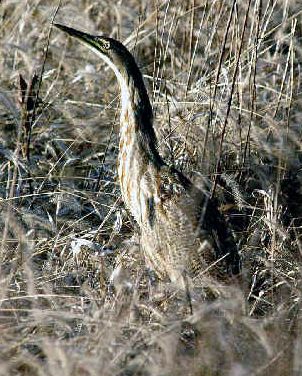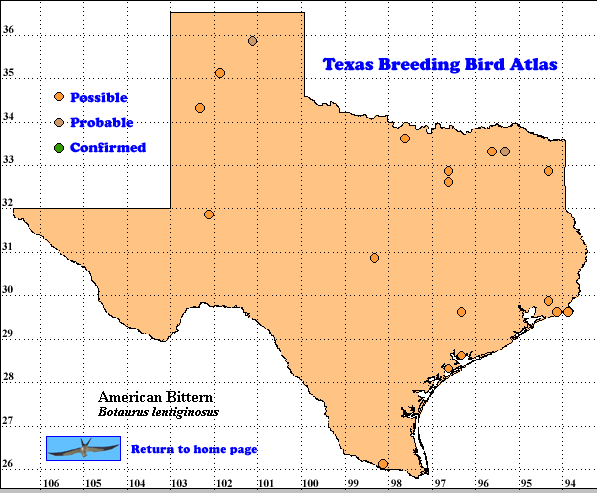In Texas, the American Bittern is primarily a migrant and winter visitor. There are only a few breeding records in widely spaced locations in the north-central and upper coastal regions of the state.
DISTRIBUTION: In Texas, there are only three known locations of breeding American Bitterns: Wilbarger County along the Red River in north-central Texas at Watt’s Lake (eggs, May 2 and 5, 1921; May 4, 1923; May 5 and 17, 1926; and May 5, 1927; the lake was drained in the 1940s for pasture land); near Vernon (eggs, May 8, 1921 and young seen, Aug. 14, 1931); and, on the upper coast (Galveston County, eggs, April 13, 1941) and in Chambers County (a captured juvenile at Anahuac National Wildlife Refuge, June 6, 2004). Breeding records also exist for Wilbarger County in the north-central inland region and Chambers and Galveston counties on the upper coast; and indications of possible breeding from Delta and Grayson counties in the north-east and north-central regions, and El Paso County in the Trans-Pecos region (Oberholser 1974, Lockwood 2004). However, although no nests have been seen, there are sight records during the breeding season in Grayson County at Hagerman National Wildlife Refuge (June 1955, 1956, 1965, and 1969 and from July 24 to September 11, 1980, July 23, 1981, and July 18, 1984. There is also an isolated date of July 21, 1983 for Denton County (Pulich 1988).
SEASONAL OCCURRENCE: American Bitterns breed from early April to late August; with egg dates from April 13-May 17; young recorded, August 14 (Oberholser 1974). Migrants are; rare to locally uncommon in the eastern third of the state and, generally rare west to the Trans-Pecos where they are very rare to casual. In winter, American Bitterns are rare to uncommon resident on the Coastal Prairies and scattered locations inland as far as the Panhandle (Lockwood and Freeman 2004).
BREEDING HABITAT: American Bitterns breed in cattail (Typha spp.) and bulrush (Scirpus spp.) marshes of 0.1-1,000 ha (0.25-2500 acres); but are more abundant on larger wetlands (Gibbs et al. 1992). Nests are placed among dense emergent vegetation over water 5-20 cm (2-8 in) in depth; but, occasionally over dry ground among dense, tall (>30 cm [> 12 in]) herbaceous cover in grassland (Duebbert and Lokemoen 1977).
STATUS: It is curious that the only known breeding sites of the American Bittern in Texas are so few and widely spaced in both time and space. However, this species is so cryptically-colored, secretive, and restricted to marshland habitats of various sizes that there could be more nestings than are known, especially during wet springs/summers.
Text by Raymond C. Telfair II (2007)
Literature cited.
Duebbert, H. F. and J. T. Lokemoen. 1977. Upland nesting of American Bitterns, Marsh Hawks, and Short-eared Owls. Prairie Nat. 9: 33-39.
Gibbs, J. P., S. Melvin, and F. A. Reid. 1992. American Bittern (Botaurus lentiginosus) In The Birds of North America, No. 18 (A. Poole, P. Stettenheim, and F. Gill, eds.). The Birds of North America, Inc., Philadelphia:, PA.
Lockwood, M. W. 2004. Texas (nesting season). N. Am. Birds. 57: 513-518.
Lockwood, M. W. and B. Freeman. 2004. The TOS handbook of Texas birds. Texas A&M. University Press, College Station.
Oberholser, H. C. 1974. The bird life of Texas, University of Texas Press, Austin.
Pulich, W. M. 1988. The birds of north central Texas. Texas A&M University Press., College Station.

